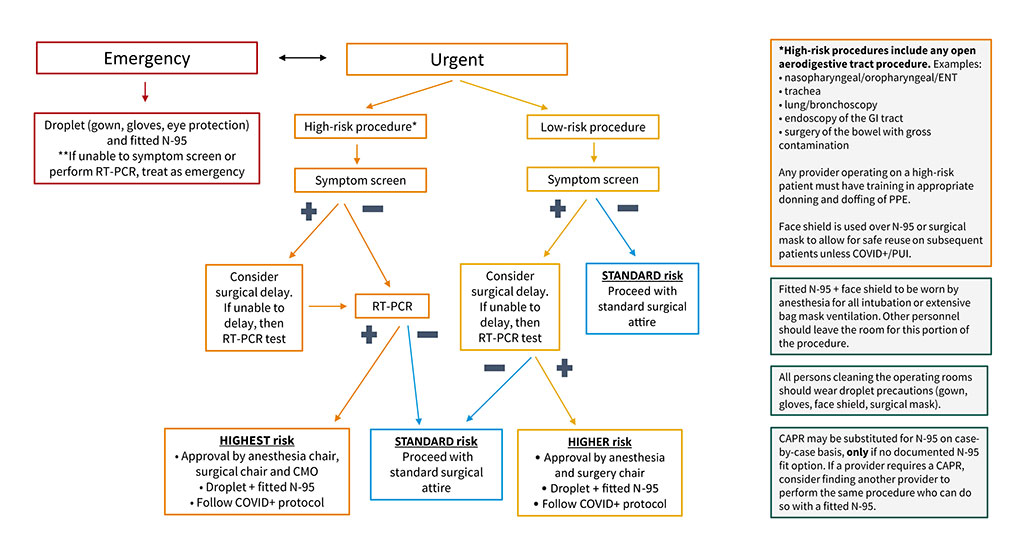New OR Safety Recommendations for COVID-19 Pandemic
|
By HospiMedica International staff writers Posted on 19 May 2020 |

Image: The Stanford COVID-19 surgical decision-tree algorithm (Photo courtesy of JACC)
A decision-tree algorithm designed to protect operating room (OR) staff assumes that every patient is potentially infected with COVID-19, until proven otherwise.
The recommendations, devised by surgeons at Stanford University (CA, USA), are designed to protect OR staff, while at the same time conserving personal protective equipment (PPE) use. The recommendations include:
• For emergency procedures (or in situation where SARS-CoV-2 testing is not possible before surgery), personnel should use full PPE, including gown, gloves, eye protection, and a fitted N-95 respirator mask.
• Urgent procedures on symptomatic patients should be delayed if possible. If the procedure cannot be delayed, patients should undergo SARS-CoV-2 testing. Any urgent procedure where testing is positive should be approved by the anesthesia and surgical chair, and if the procedure is approved, personnel should use full PPE and follow the hospital's protocol for COVID-19 patients.
• Asymptomatic patients scheduled for high-risk procedures who test negative for SARS-CoV-2 and asymptomatic patients scheduled for low-risk procedures can proceed to surgery where OR members use standard surgical attire.
• For all intubations or extensive bag-mask ventilation, anesthesia personnel should wear a fitted N-95 mask plus face shield, and other personnel should leave the room for this portion of the procedure to avoid possible droplet and aerosol infection.
•
“This algorithm is based on the urgency of the operation, anticipated viral burden at the surgical site, opportunity for a procedure to aerosolize virus, and likelihood a patient could be infected based on symptoms and testing,” concluded lead author Joseph D. Forrester, MD, and colleagues. “It prioritizes patients based on disease severity, testing status, and symptoms, while ensuring rational use of PPE in a resource-constrained setting. It has been shared with healthcare providers and stakeholders nationwide and is expected to be widely adopted.”
At the time the guideline algorithm was created there was a nationwide shortage of N-95 face masks in the United States. To conserve the institution's supply, the algorithm requires a face shield to be placed over the mask. The U.S. federal government has recently announced that millions of face masks, face shields, surgical masks, gloves, and gowns are entering the medical supply chain.
Related Links:
Stanford University
The recommendations, devised by surgeons at Stanford University (CA, USA), are designed to protect OR staff, while at the same time conserving personal protective equipment (PPE) use. The recommendations include:
• For emergency procedures (or in situation where SARS-CoV-2 testing is not possible before surgery), personnel should use full PPE, including gown, gloves, eye protection, and a fitted N-95 respirator mask.
• Urgent procedures on symptomatic patients should be delayed if possible. If the procedure cannot be delayed, patients should undergo SARS-CoV-2 testing. Any urgent procedure where testing is positive should be approved by the anesthesia and surgical chair, and if the procedure is approved, personnel should use full PPE and follow the hospital's protocol for COVID-19 patients.
• Asymptomatic patients scheduled for high-risk procedures who test negative for SARS-CoV-2 and asymptomatic patients scheduled for low-risk procedures can proceed to surgery where OR members use standard surgical attire.
• For all intubations or extensive bag-mask ventilation, anesthesia personnel should wear a fitted N-95 mask plus face shield, and other personnel should leave the room for this portion of the procedure to avoid possible droplet and aerosol infection.
•
“This algorithm is based on the urgency of the operation, anticipated viral burden at the surgical site, opportunity for a procedure to aerosolize virus, and likelihood a patient could be infected based on symptoms and testing,” concluded lead author Joseph D. Forrester, MD, and colleagues. “It prioritizes patients based on disease severity, testing status, and symptoms, while ensuring rational use of PPE in a resource-constrained setting. It has been shared with healthcare providers and stakeholders nationwide and is expected to be widely adopted.”
At the time the guideline algorithm was created there was a nationwide shortage of N-95 face masks in the United States. To conserve the institution's supply, the algorithm requires a face shield to be placed over the mask. The U.S. federal government has recently announced that millions of face masks, face shields, surgical masks, gloves, and gowns are entering the medical supply chain.
Related Links:
Stanford University
Latest Surgical Techniques News
- Minimally Invasive Endoscopic Surgery Improves Severe Stroke Outcomes
- Novel Glue Prevents Complications After Breast Cancer Surgery
- Breakthrough Brain Implant Enables Safer and More Precise Drug Delivery
- Bioadhesive Sponge Stops Uncontrolled Internal Bleeding During Surgery
- Revolutionary Nano Bone Material to Accelerate Surgery and Healing
- Superior Orthopedic Implants Combat Infections and Quicken Healing After Surgery
- Laser-Based Technique Eliminates Pancreatic Tumors While Protecting Healthy Tissue
- Surgical Treatment of Severe Carotid Artery Stenosis Benefits Blood-Brain Barrier
- Revolutionary Reusable Duodenoscope Introduces 68-Minute Sterilization
- World's First Transcatheter Smart Implant Monitors and Treats Congestion in Heart Failure
- Hybrid Endoscope Marks Breakthrough in Surgical Visualization
- Robot-Assisted Bronchoscope Diagnoses Tiniest and Hardest to Reach Lung Tumors
- Diamond-Titanium Device Paves Way for Smart Implants that Warn of Disease Progression
- 3D Printable Bio-Active Glass Could Serve as Bone Replacement Material
- Spider-Inspired Magnetic Soft Robots to Perform Minimally Invasive GI Tract Procedures
- Micro Imaging Device Paired with Endoscope Spots Cancers at Earlier Stage
Channels
Critical Care
view channel
AI Heart Attack Risk Assessment Tool Outperforms Existing Methods
For decades, doctors have relied on standardized scoring systems to assess patients with the most common type of heart attack—non-ST-elevation acute coronary syndrome (NSTE-ACS). The GRACE score, used... Read more
'Universal' Kidney to Match Any Blood Type
Blood-type incompatibility has long been one of the greatest obstacles in organ transplantation, forcing thousands of patients—particularly those with type O blood—to wait years longer for compatible donors.... Read morePatient Care
view channel
Revolutionary Automatic IV-Line Flushing Device to Enhance Infusion Care
More than 80% of in-hospital patients receive intravenous (IV) therapy. Every dose of IV medicine delivered in a small volume (<250 mL) infusion bag should be followed by subsequent flushing to ensure... Read more
VR Training Tool Combats Contamination of Portable Medical Equipment
Healthcare-associated infections (HAIs) impact one in every 31 patients, cause nearly 100,000 deaths each year, and cost USD 28.4 billion in direct medical expenses. Notably, up to 75% of these infections... Read more
Portable Biosensor Platform to Reduce Hospital-Acquired Infections
Approximately 4 million patients in the European Union acquire healthcare-associated infections (HAIs) or nosocomial infections each year, with around 37,000 deaths directly resulting from these infections,... Read moreFirst-Of-Its-Kind Portable Germicidal Light Technology Disinfects High-Touch Clinical Surfaces in Seconds
Reducing healthcare-acquired infections (HAIs) remains a pressing issue within global healthcare systems. In the United States alone, 1.7 million patients contract HAIs annually, leading to approximately... Read moreHealth IT
view channel
Printable Molecule-Selective Nanoparticles Enable Mass Production of Wearable Biosensors
The future of medicine is likely to focus on the personalization of healthcare—understanding exactly what an individual requires and delivering the appropriate combination of nutrients, metabolites, and... Read moreBusiness
view channel
Philips and Masimo Partner to Advance Patient Monitoring Measurement Technologies
Royal Philips (Amsterdam, Netherlands) and Masimo (Irvine, California, USA) have renewed their multi-year strategic collaboration, combining Philips’ expertise in patient monitoring with Masimo’s noninvasive... Read more
B. Braun Acquires Digital Microsurgery Company True Digital Surgery
The high-end microsurgery market in neurosurgery, spine, and ENT is undergoing a significant transformation. Traditional analog microscopes are giving way to digital exoscopes, which provide improved visualization,... Read more
CMEF 2025 to Promote Holistic and High-Quality Development of Medical and Health Industry
The 92nd China International Medical Equipment Fair (CMEF 2025) Autumn Exhibition is scheduled to be held from September 26 to 29 at the China Import and Export Fair Complex (Canton Fair Complex) in Guangzhou.... Read more













